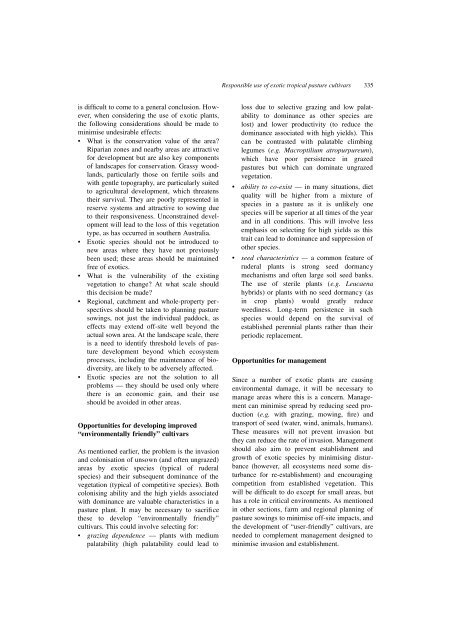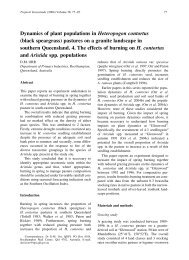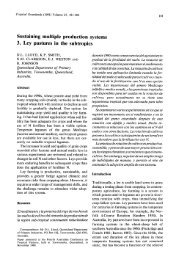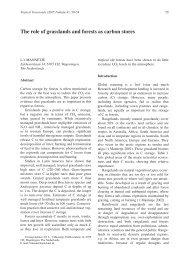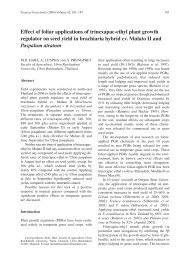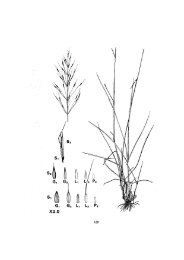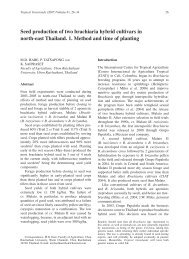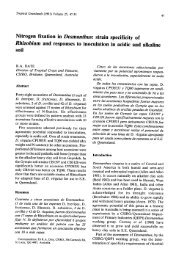Responsible use of exotic tropical pasture cultivars â an ecological ...
Responsible use of exotic tropical pasture cultivars â an ecological ...
Responsible use of exotic tropical pasture cultivars â an ecological ...
Create successful ePaper yourself
Turn your PDF publications into a flip-book with our unique Google optimized e-Paper software.
<strong>Responsible</strong> <strong>use</strong> <strong>of</strong> <strong>exotic</strong> <strong>tropical</strong> <strong>pasture</strong> <strong>cultivars</strong> 335<br />
is difficult to come to a general conclusion. However,<br />
when considering the <strong>use</strong> <strong>of</strong> <strong>exotic</strong> pl<strong>an</strong>ts,<br />
the following considerations should be made to<br />
minimise undesirable effects:<br />
• What is the conservation value <strong>of</strong> the area?<br />
Ripari<strong>an</strong> zones <strong>an</strong>d nearby areas are attractive<br />
for development but are also key components<br />
<strong>of</strong> l<strong>an</strong>dscapes for conservation. Grassy woodl<strong>an</strong>ds,<br />
particularly those on fertile soils <strong>an</strong>d<br />
with gentle topography, are particularly suited<br />
to agricultural development, which threatens<br />
their survival. They are poorly represented in<br />
reserve systems <strong>an</strong>d attractive to sowing due<br />
to their responsiveness. Unconstrained development<br />
will lead to the loss <strong>of</strong> this vegetation<br />
type, as has occurred in southern Australia.<br />
• Exotic species should not be introduced to<br />
new areas where they have not previously<br />
been <strong>use</strong>d; these areas should be maintained<br />
free <strong>of</strong> <strong>exotic</strong>s.<br />
• What is the vulnerability <strong>of</strong> the existing<br />
vegetation to ch<strong>an</strong>ge? At what scale should<br />
this decision be made?<br />
• Regional, catchment <strong>an</strong>d whole-property perspectives<br />
should be taken to pl<strong>an</strong>ning <strong>pasture</strong><br />
sowings, not just the individual paddock, as<br />
effects may extend <strong>of</strong>f-site well beyond the<br />
actual sown area. At the l<strong>an</strong>dscape scale, there<br />
is a need to identify threshold levels <strong>of</strong> <strong>pasture</strong><br />
development beyond which ecosystem<br />
processes, including the mainten<strong>an</strong>ce <strong>of</strong> biodiversity,<br />
are likely to be adversely affected.<br />
• Exotic species are not the solution to all<br />
problems — they should be <strong>use</strong>d only where<br />
there is <strong>an</strong> economic gain, <strong>an</strong>d their <strong>use</strong><br />
should be avoided in other areas.<br />
Opportunities for developing improved<br />
“environmentally friendly” <strong>cultivars</strong><br />
As mentioned earlier, the problem is the invasion<br />
<strong>an</strong>d colonisation <strong>of</strong> unsown (<strong>an</strong>d <strong>of</strong>ten ungrazed)<br />
areas by <strong>exotic</strong> species (typical <strong>of</strong> ruderal<br />
species) <strong>an</strong>d their subsequent domin<strong>an</strong>ce <strong>of</strong> the<br />
vegetation (typical <strong>of</strong> competitive species). Both<br />
colonising ability <strong>an</strong>d the high yields associated<br />
with domin<strong>an</strong>ce are valuable characteristics in a<br />
<strong>pasture</strong> pl<strong>an</strong>t. It may be necessary to sacrifice<br />
these to develop “environmentally friendly”<br />
<strong>cultivars</strong>. This could involve selecting for:<br />
• grazing dependence — pl<strong>an</strong>ts with medium<br />
palatability (high palatability could lead to<br />
loss due to selective grazing <strong>an</strong>d low palatability<br />
to domin<strong>an</strong>ce as other species are<br />
lost) <strong>an</strong>d lower productivity (to reduce the<br />
domin<strong>an</strong>ce associated with high yields). This<br />
c<strong>an</strong> be contrasted with palatable climbing<br />
legumes (e.g. Macroptilium atropurpureum),<br />
which have poor persistence in grazed<br />
<strong>pasture</strong>s but which c<strong>an</strong> dominate ungrazed<br />
vegetation.<br />
• ability to co-exist — in m<strong>an</strong>y situations, diet<br />
quality will be higher from a mixture <strong>of</strong><br />
species in a <strong>pasture</strong> as it is unlikely one<br />
species will be superior at all times <strong>of</strong> the year<br />
<strong>an</strong>d in all conditions. This will involve less<br />
emphasis on selecting for high yields as this<br />
trait c<strong>an</strong> lead to domin<strong>an</strong>ce <strong>an</strong>d suppression <strong>of</strong><br />
other species.<br />
• seed characteristics — a common feature <strong>of</strong><br />
ruderal pl<strong>an</strong>ts is strong seed dorm<strong>an</strong>cy<br />
mech<strong>an</strong>isms <strong>an</strong>d <strong>of</strong>ten large soil seed b<strong>an</strong>ks.<br />
The <strong>use</strong> <strong>of</strong> sterile pl<strong>an</strong>ts (e.g. Leucaena<br />
hybrids) or pl<strong>an</strong>ts with no seed dorm<strong>an</strong>cy (as<br />
in crop pl<strong>an</strong>ts) would greatly reduce<br />
weediness. Long-term persistence in such<br />
species would depend on the survival <strong>of</strong><br />
established perennial pl<strong>an</strong>ts rather th<strong>an</strong> their<br />
periodic replacement.<br />
Opportunities for m<strong>an</strong>agement<br />
Since a number <strong>of</strong> <strong>exotic</strong> pl<strong>an</strong>ts are causing<br />
environmental damage, it will be necessary to<br />
m<strong>an</strong>age areas where this is a concern. M<strong>an</strong>agement<br />
c<strong>an</strong> minimise spread by reducing seed production<br />
(e.g. with grazing, mowing, fire) <strong>an</strong>d<br />
tr<strong>an</strong>sport <strong>of</strong> seed (water, wind, <strong>an</strong>imals, hum<strong>an</strong>s).<br />
These measures will not prevent invasion but<br />
they c<strong>an</strong> reduce the rate <strong>of</strong> invasion. M<strong>an</strong>agement<br />
should also aim to prevent establishment <strong>an</strong>d<br />
growth <strong>of</strong> <strong>exotic</strong> species by minimising disturb<strong>an</strong>ce<br />
(however, all ecosystems need some disturb<strong>an</strong>ce<br />
for re-establishment) <strong>an</strong>d encouraging<br />
competition from established vegetation. This<br />
will be difficult to do except for small areas, but<br />
has a role in critical environments. As mentioned<br />
in other sections, farm <strong>an</strong>d regional pl<strong>an</strong>ning <strong>of</strong><br />
<strong>pasture</strong> sowings to minimise <strong>of</strong>f-site impacts, <strong>an</strong>d<br />
the development <strong>of</strong> “<strong>use</strong>r-friendly” <strong>cultivars</strong>, are<br />
needed to complement m<strong>an</strong>agement designed to<br />
minimise invasion <strong>an</strong>d establishment.


